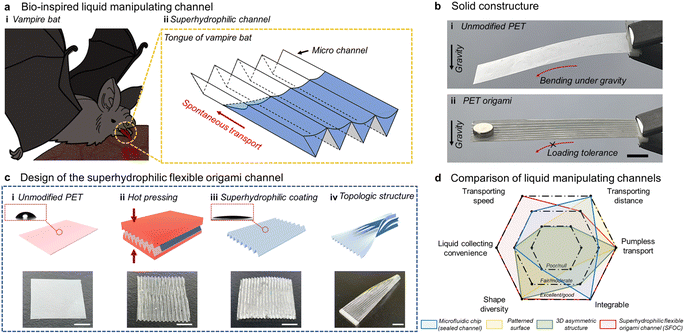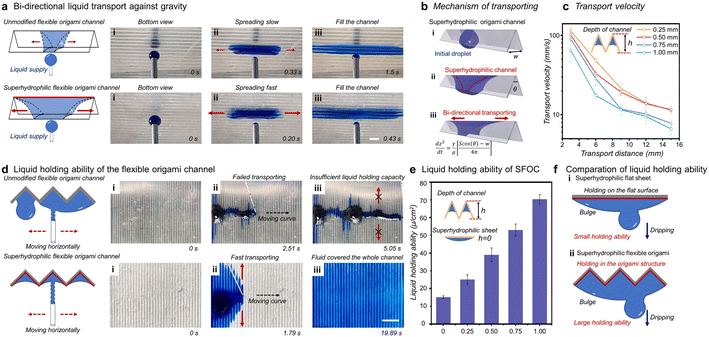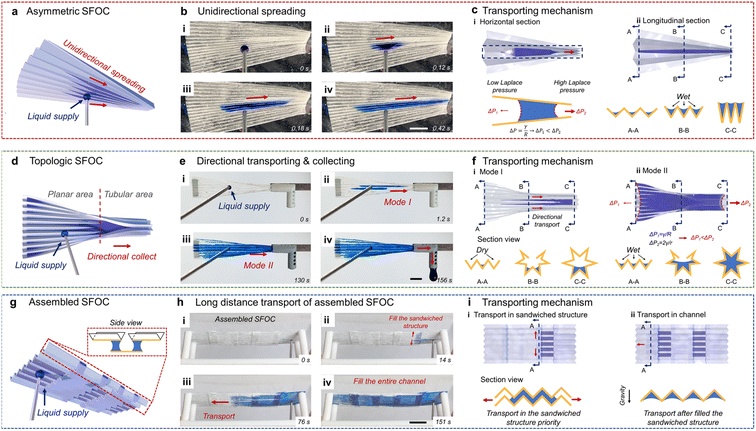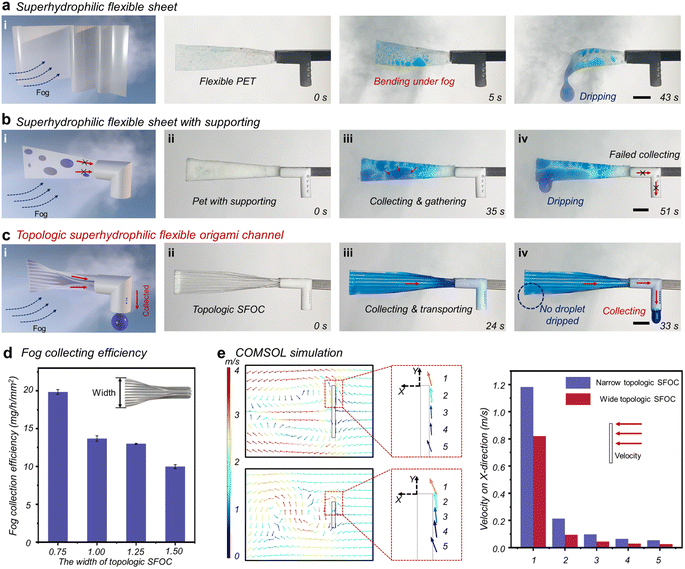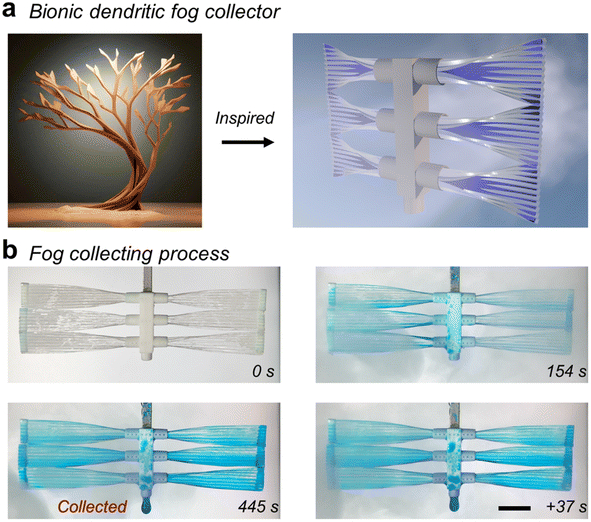Vampire bat's tongue-inspired superhydrophilic flexible origami channel for directional and spontaneous liquid manipulation†
Zhihang
Ye‡
a,
Jingyi
Zhao‡
a,
Qianrui
Tong
a,
Xinsheng
Wang
a,
He
Sun
a,
Haoyu
Bai
*b,
Kesong
Liu
d and
Moyuan
Cao
 *ac
*ac
aSchool of Materials Science and Engineering, Smart Sensing Interdisciplinary Science Centre, Nankai University, Tianjin 300350, P.R. China. E-mail: mycao@nankai.edu.cn
bSchool of Chemical Engineering and Technology, Tianjin University, Tianjin, 300072, P. R. China. E-mail: bhyy@tju.edu.cn
cTianjin Key Laboratory of Metal and Molecule-Based Material Chemistry, Tianjin 300192, P. R. China
dSchool of Chemistry, Beihang University, Beijing 100083, P.R. China
First published on 28th May 2024
Abstract
Achieving continuous, directional fluid manipulation without external energy input is promising in current systems. However, designing a spontaneous fluid manipulating system with simplified fabrication, deformation, and integration remains challenging. Inspired by a vampire bat's tongue, herein, a superhydrophilic flexible origami channel (SFOC) with parallel-arranged superhydrophilic V-grooves is proposed to improve liquid transport and holding capability against gravity. The SFOC with a 1 mm depth can reach a maximum transport speed of 65 mm s−1 and a liquid holding ability of 70 μL cm−2, which is about 4.6 times higher than that of a superhydrophilic sheet. The rigidity of the material enables continuous liquid transport up to 7 cm through assembly. Coupled with the material's flexibility, a complex topological SFOC is designed, further facilitating directional fluid transport. The topological SFOC is further applied in fog collection to expand its functionality. Compared with the flexible superhydrophilic sheet, harvested fog water can be directionally transported and collected. Furthermore, a branch-inspired all-in-one liquid collector is designed, which can achieve a gravity-independent fog collection process as well as directional fog water transport and collection process in one step. We believe this work simplifies the fabrication of fluid transfer platforms and introduces effective strategies for fluid manipulation through 3D deformation and assembly, enhancing their suitability for practical fluid manipulation applications.
Introduction
Efficient liquid manipulating processes have been considered an indispensable factor for optimizing the current functional systems such as heterogeneous catalysis,1,2 cooling systems,3,4 and water electrolysis.5,6 Although the pumping technique can achieve fast and controllable fluid distribution, the cost of energy and equipment should be further lowered to meet the requirements in developing and remote areas. According to industrial statistics, 25–50% energy of an average factory is consumed by the pumping process, including fluid transport and gas compression, indicating that there is a great need for further development.7 More importantly, the tedious pumping machine and pipes may hamper their integration with specific systems for precise delivery and miniaturization.8,9 Therefore, achieving spontaneous and continuous fluid transport without external power input should be a promising strategy for improving the existing systems.10–12After millions of years of evolution and natural selection, plants and animals possess several unique and smart methods for controlling fluids in an energy-saving way.13,14 Through the repetitive asymmetric grooves with Taylor cones, a pitcher plant can continuously uplift liquid to its peristome, forming a lubricant layer for trapping insects.15,16 The Janus wettability of a lotus leaf can guarantee the floating state via downward liquid drainage and interfacial anchoring with the air/water interface.17,18 To maintain surface moisture, animal corneas have evolved a superhydrophilic hierarchical surface that captures a thin layer of fluid.19 Among the natural examples, the capillary force of the hydrophilic channel and the anisotropic Laplace pressure from deformed droplets contribute to fluid control, which inspire us to innovate fluid-manipulating interfaces with bioinspired structures.20–23
Typical paradigms of a fluid-manipulating interface are based on the wettability contrast/gradient,24,25 oriented micro-/nano-structures,26,27 and geometric asymmetry,28,29 exhibiting distinguishable properties in controlling fluid behavior. For example, surfaces possessing wettability differences can precisely fix the shape and distribution of fluid in a relatively short distance.30 The incorporation of tilted micro-/nano-structure can facilitate a unidirectional liquid transport driven by the unbalanced motion resistance from the front and back sides of fluids.31 Asymmetric geometric shape, including cone, triangle, and V-shape groove, is applicable to long-distance, continuous, and high flux fluid transport, originating from the considerable fluid holding ability and directional capillary force on the macroscopic interfaces.32–34 Moreover, the ratio integration of different types of the fluid-manipulating interface can offer a powerful tool to deal with complicated situations of fluid control, which have been demonstrated as the examples of fog collection,35–39 multi-bioinspired vapor condenser,40 and Janus triangle electrodes array for electrolysis.5
With respect to liquid transport in nature, the vampire bat can uptake the blood from the cow's wound, which depends on the hydrophilic groove channel on its tongue.41 Unlike the conventional tongues with barbed structures of other animals,42,43 this smooth and flexible surface could rapidly suck blood with a painless approach. By taking inspiration from the tongue structure of a vampire bat, herein, we present a superhydrophilic flexible origami channel (SFOC) for liquid collection and transport toward real-world applications, such as liquid transport, fluid capture, and fog harvesting (Fig. 1a). Through the hot pressing with machining templates, the flexible polyester film was converted as the origami channel with enhanced structure stiffness. After the superhydrophilic modification, the origami channel can promote a fast liquid spreading (of 65 mm s−1) and considerable liquid holding ability (of 70 μL cm−2). Building on the flexibility of this origami structure, the assembly and topologic deformation of the channel can easily be fulfilled, facilitating a series of directional and diversified liquid transporting processes. Finally, the fog harvesting performance of this flexible origami channel has been tested, showing an all-in-one function of micro-droplet collection and directional liquid transport. We believe that this flexible origami channel can provide a valuable platform for high-flux and directional liquid transport, which effectively lowers the difficulty of integration and applications of fluid-manipulating interfaces in current systems.
Results and discussion
Unlike most animals that obtain liquids through sucking, licking, and drinking, vampire bats have evolved a complex set of structures specifically tailored to their unique dietary requirements: the ingestion of blood. As reported by Glass et al., the bats typically select larger mammals as their food sources.41 To access greater volumes of blood, vampire bats use specialized dentition to create small incisions in the skin of their prey. These bites are precisely deep enough to sever capillaries, allowing the blood to seep out and accumulate in the created well. Beyond their teeth, the bat's tongue exhibits unique structures and functions during feeding. Its surface is lined with micro-grooved channels arranged in parallel. The musculature of the bat's tongue facilitates the propulsion of blood through these grooves, enabling efficient liquid obtaining. Inspired by the microchannel on the bat's tongue, the origami with parallel-arranged superhydrophilic channels is proposed. This superhydrophilic channel origami is composed of multiple V-shaped, superhydrophilic grooves designed to mimic the surface topology of a vampire bat's tongue. Similar to the blood-sipping action of the bat, liquids rapidly spread across the biomimetic V-shaped grooves and are efficiently channeled along the channels (Fig. 1a). The superhydrophilic flexible origami channel (SFOC) processes improved the liquid manipulating ability and enhanced the rigidity and load-bearing capacity of the materials. The polyethylene terephthalate (PET) origami is significantly more resistant to bending in the direction parallel to the channel, while flexibility is still maintained in the direction perpendicular to the origami (Fig. S1†). As shown in Fig. 1b, to verify the bending resistance of the origami structure, both the thin PET sheet and origami were fixed at one end. The thin PET sheet bends under gravity without carrying an additional weight. In comparison, even if a weight of 2.4 g is applied to the far end, the origami is stable and remains straight. The increased resistance to bending of the origami structures can be attributed to the formation of arch-like configurations within the V-shaped channels. The robustness of origami ensures the stability of fluid transport in complex application fields, even when carrying liquids with large volumes.Fig. 1c illustrates the fabrication steps from an unmodified PET sheet to a complex topological superhydrophilic flexible origami channel (SFOC). Ordinary PET sheets, which initially lack the fluid manipulation capacity and structural strength, are transformed using a hot pressuring process through a mental mold. The hot pressuring method reshapes the initial PET sheet into an origami structure, which includes parallel-aligned V-shaped channels with defined dimensions. To further enhance the fluid manipulating capability, the origami channels are treated with silica sol-based complex coating to induce superhydrophilicity. The SEM images are displayed in Fig. S2.† Taking advantage of the flexible character in the perpendicular direction, the SFOC can be constructed as a more complex topological structure. One side of the SFOC remains fixed, while the other side is curled into a tubular shape, resulting in a complex assembly of planar origami and tube origami. This configuration leads to a continuous structural transition from open-surface to tube, enhancing the material's capabilities in directional fluid transport and efficient liquid collection. In addition, SFOC was further compared with some representative fluid transport materials, and SFOC excelled in terms of transport speed, liquid collecting convenience, pumpless transport, etc. (Fig. 1d).
After the superhydrophilic modification, the origami channel exhibits impressive fluid transport capabilities. The unmodified flexible origami channel with a surface contact angle of 9.5 ± 0.7° should impede the rapid spread of fluid. In contrast, origami channels with superhydrophilic coatings significantly enhance the velocity of liquid transport. As shown in Fig. 2a, droplets were continuously released from a hydrophobically treated syringe positioned 2.5 mm beneath the origami structure, and the flow rate was 5 mL h−1. Both untreated and superhydrophilic-modified channels facilitate liquid transport against gravity, but the transport speed varies greatly (Movie S1†). With the same transport distance, the untreated origami channel requires 1.5 s to achieve complete coverage in the channel, while the hydrophilic-coated channel completes the entire distance transport in just 0.43 s. The spreading speed of the hydrophilic channel is roughly four times faster than that of the unmodified channel. The enhanced transport rate can be attributed to the improved surface wettability of the channel. With the introduction of the superhydrophilic surface, the liquid can establish a more curved liquid meniscus during the spreading process, leading to improved Laplace pressure, which accelerates the spreading of the fluid within the channel.44,45 The spreading process of channels with varying depths is illustrated in Fig. S3 and S4.† In addition, the liquid transport process under gravity is illustrated in Fig. S5,† demonstrating the enhanced liquid manipulating ability of the superhydrophilic channel. The improved transport speed is the main attribute of the enhanced wettability, which reduces the curvature radius of the liquid. Therefore, advanced Laplace pressure is achieved (Fig. 2b). According to previous studies,46–48
Furthermore, the fluid spreading velocities were measured on various parameters of the superhydrophilic surface, with corresponding data collected at 3 mm intervals (Fig. 2c). The spreading velocity of the fluid in the superhydrophilic channel decreases gradually as the transport distance increases. During the initial two 3 mm-length transport processes, the average spreading velocity of channels of all sizes experienced a significant reduction, with the most substantial decrease being 73%. However, during the final liquid transport processes, the velocity gradually stabilizes, with the maximum decrease being only 16%. The high-speed liquid transport in the initial stage could be attributed to the combined influence of Laplace pressure and the release of droplet surface energy. As the spreading process advances, the droplet's surface energy is consumed, and the Laplace pressure is the only driving force for liquid transport. Therefore, the velocity of liquid transport tends to be stable in subsequent stages. Besides, the reduction in liquid transport velocity during the initial stages with channels of varying depths is analyzed. Smaller channels exhibit reduced transport flux, leading to an extended time for droplet spreading. Consequently, as the channel depth increases, the reduction in transport speed becomes more significant, indicating that smaller channels exhibit a greater impact from the released surface energy.
In addition to the anti-gravity liquid manipulating capability, the advantages of the superhydrophilic coating are more significant in the liquid holding ability against gravity. As shown in Fig. 2d, the liquid flux was increased to 250 mL h−1 and water flow was ejected below the SFOC, while moving the syringe perpendicular to the channel direction at 8 mm s−1. Due to the absence of surface tension release from the droplets, the untreated origami channels encounter challenges in collecting substantial liquid against gravity. Following the initial liquid transport in the channel over a short distance, the transport speed significantly diminishes, and the liquid fails to fully cover the entire surface (Fig. S6†). Conversely, SFOC can effectively absorb and transport spread liquid. Upon the impact of a substantial volume of liquid against gravity on the lower surface of the SFOC, the liquid swiftly disperses throughout the superhydrophilic channel until it fills the entire surface (Movie S2†). Subsequently, the excess liquid beyond the hold capability gathered and dripped eventually (Fig. S7†). In addition, the liquid holding ability was assessed through continuous droplet addition against gravity. Because the superhydrophilic surface resists spreading against gravity (Fig. S8 and S9†), it is prewetted to assess its liquid retention capacity. An SFOC with a depth of 1 mm demonstrates a liquid holding ability of 70 μL cm−2, which is approximately 4.6 times the liquid holding capacity compared to a superhydrophilic sheet (Fig. 2e). The significant liquid holding capacity of the SFOC is primarily attributed to its effective manipulation of liquid spreading in the channel, even under anti-gravity conditions. Besides, the origami channel offers additional storage capacity for accommodating larger volumes of liquids (Fig. 2f). The enhanced anti-gravity liquid holding capability of the SFOC enables its application in many fields, including liquid collection, evaporating cooling, and environmental humidification.
The flexible characteristics of SFOC are promising for designing complex 3D structures, enabling more complex capabilities, including unidirectional liquid transporting, droplet collecting and fog harvesting. Taking advantage of the flexible properties of SFOC, the flexible origami was folded on one side and stretched on the other side (Fig. 3a). Finally, the parallel origami V-shaped channel changed to a dual-asymmetric channel, and the overall shape also changed to a sector shape. As shown in Fig. 3b, the droplet was released under a dual-asymmetric flexible origami and was self-pumped in the dual-asymmetric channel (Movie S3†). Subsequently, the liquid is directionally self-pumped to the narrow end against gravity. Through the analysis of the section diagram, the asymmetric structure of the horizontal section can form a small radius of curvature on the narrow end of the liquid and a large radius of curvature on the wide end. The Laplace of the droplets can be estimated using the following equation:
In addition to the transformation in the horizontal plane, SFOC can undergo a further three-dimensional transformation due to the material's combination of rigidity and flexibility. One end of the SFOC curls to form a cylinder, while the other end remains unchanged, resulting in a 3D topologically asymmetric structure. Compared with the previous asymmetric SFOC, the single origami channel retains the characteristic of dual-asymmetry. Nevertheless, the overall structure undergoes a significant transformation, evolving into an organic combination of fan-shaped and tubular regions (Fig. 3d). As shown in Fig. 3e, the topological SFOC was positioned perpendicular to the ground, a liquid collector was connected at the end of the tube, and continuous droplets were deposited onto the surface at a rate of 5 mL h−1. Initially, the liquid was directed through the channel towards the end of the tubular area. Subsequently, as the liquid was continuously discharged, the collected liquid accumulated in the tubular structure. Ultimately, excessive liquid was collected and released by the liquid collector through the siphon effect (Movie S4†). Throughout the entire procedure, all droplets are collected and released from the liquid collector, with no droplets dripping from the topological SFOC surface (Fig. S10†).
The mechanism of the directional liquid collection is illustrated in Fig. 3f. Throughout the continuous introduction of the liquid, the directional transport process can be separated into two distinct modes: the liquid spreading process in a single channel (Mode I) and the subsequent liquid transport process after the liquid has filled in the tube (Mode II). In Mode I, the 3D transforming process results in the formation of a double asymmetric channel that gradually narrows from the fan area to the tube area. The degree of variation in the apex angle of the channels from wide to narrow is explained, as shown in the ESI and Fig. S11.† Consequently, the single droplet tends to spread towards the narrow ends of the double asymmetric channel. Upon complete infiltration of the topological SFOC through the continuous collection of water droplets, a large curved liquid surface is formed on the open planar surface. In contrast, the tube is gradually filled with liquid and transformed into a sealed capillary tube. In the case of the fan area, the liquid is restricted by only two sides. Therefore, the Laplace pressure can be expressed as follows:
In contrast, in the capillary tube, the liquid is fully restricted; therefore, we have
In addition, the radius of curvature of the liquid surface within the capillary tube is significantly smaller than that observed on the exposed planar surface. Consequently, driven by the asymmetric Laplace pressure, the liquid is directed into the tube structure, accumulates within the interconnected liquid collector, and is ultimately discharged via the siphon effect.
In addition to the flexibility for easy shaping, the rigid characteristic of a regularly arranged V-groove structure holds the potential for effective assembling. Through the parallel and overlapping placement of multiple SFOCs, the liquid can be continuously transported over extended distances across multiple SFOCs (Fig. 3g). As shown in Fig. 3h, during the spreading process, the liquid is applied to the lower surface of the SFOC against gravity. Initially, the liquid is transported on the lower surface of the first SFOC and subsequently extended on the upper surface of the second SFOC. Continuing in this manner, the liquid is ultimately transported across the five SFOCs to reach the end. The total transport distance is extended to 7 cm (Movie S5†). The mechanism of liquid spreading between the sandwiched overlapping structures is illustrated in Fig. 3i. Once the fluid reaches the sandwiched overlap structure of the two SFOC layers, the liquid is preferentially spread within the sandwiched structure through the influence of capillary forces. After the sandwiched structure is fully spread, the liquid starts to infiltrate into the next SFOC. This sandwiched design serves as a buffer, ensuring the uniform distribution of the liquid across the entire surface.
The simplicity and eco-friendly nature of fog harvesting make it promising, offering a cost-effective solution for freshwater acquisition without the need for external energy inputs. Particularly advantageous in arid regions with frequent fog resources, this approach presents a viable option for local communities facing water scarcity.49–51 In this study, we propose a topological fog collector upon the foundation of a biomimetic superhydrophilic origami channel, which is inspired by the vampire bat's feeding mechanism. Owing to its superior liquid transport and collection capabilities, the topological SFOC is utilized in the domain of fog harvesting. Compared with topological SFOC, conventional superhydrophilic PET lacks wind resistance and tends to bend when exposed to fog flow. The bending impedes fog capture and leads to irregular movement of the collected liquid along the surface within the fog flow, posing challenges to effective collection. As shown in Fig. 4a, the flexible PET sheet is bent backward by the fog flow, thereby obstructing the direct impact of the fog stream on the surface. The collected droplets are challenging to collect and tend to drip directly from the tip of the PET. By incorporating support on the back of the superhydrophilic PET, the fog collector becomes rigid enough to resist deformation under the fog stream. Nevertheless, the harvested fog water can be released only from the tip of the PET under the influence of gravity (Fig. 4b). During this process, the dripped fog water is easily deflected by fog, further enhancing the difficulty of collecting (Fig. S12†). In addition, the growth process of droplets during fog collection is directly exposed to the fog stream, which leads to the risk of collected water re-evaporating in practical applications, thereby reducing fog collection efficiency. Conversely, the topological SFOC exhibits greater rigidity in the direction parallel to the origami channel, enabling it to effectively withstand fog blowing forces without bending (Fig. 4c). More importantly, the captured water can be efficiently directed into the liquid collector through directional transport, thereby minimizing the risk of re-evaporation on the fog collecting surface (Movie S6†). The directional transport ability disappeared until the width of the SFOC was increased to 1.75 mm (Fig. S13†). By improving water collection capacity, the efficiency of fog collection in practical applications is significantly enhanced.
To optimize the topological SFOC for improved fog collection, several experiments were conducted by varying the width of the SFOC. As the width of the topological SFOC increased, the fog collection efficiency gradually decreased (Fig. 4d). The dew collection efficiency of the topological SFOC with a width of 1.25 mm was observed to be approximately 50% lower than that of the topological SFOC with a width of 0.75 mm. The COMSOL Multiphysics simulation was used to simulate the effect of SFOC of different widths on airflow in a fog stream. As shown in Fig. 4e, the origami structure of the SFOC is simplified to a thin sheet. In the simulation, simplified SFOC of two different widths were utilized for comparison, with the shorter width being half that of the longer width. The simulation enables a clear depiction of the wind field near the front surface of the sheet. The wind vector near the simplified SFOC is divided into two components: the wind blowing perpendicular to the plane (X-direction) and the wind parallel to the plane (Y-direction). Fog collection is a process in which tiny droplets suspended in airflow collide with a surface. As the airflow approaches perpendicularly within the boundary layer (X-direction), it abruptly changes direction near the solid surface due to the compression and resistance of the gas. Due to the great mass relative to the airflow, the tiny droplets swiftly collide with the surface, leading to efficient collection. Conversely, airflow parallel to the surface undergoes no significant direction change (Y-direction), making it challenging for the suspended droplets to collide with the surface. Hence, the velocity in the X-direction of the airflow can effectively represent the fog collection efficiency. Five points are selected from the sheet's center to its edge to assess and compare airflow sizes at various positions along the X-direction, revealing that the wind speed in the X-direction of the wider sheet is lower than that of the narrower sheet. Therefore, the narrow sheet can more effectively promote airflow deflection, thereby offering greater advantages in the capturing process.
Based on the effective fog collection and directional liquid collection capabilities of topological SFOC, and inspired by branch structures, a bio-inspired integrated fog collector with directional transport and collection functionalities is designed. By further extending the liquid collector, multiple topological SFOCs can be assembled in a branching configuration (Fig. 5a). As shown in Fig. 5b, during the fog collection process, the collected fog water of all the topological SFOC is transported and gathered directionally to the integrated liquid collector and ultimately collected at one exit. Through integration, the branch-inspired fog collector significantly enhances the efficiency of transporting and collecting fog water while reducing the potential pollution and re-evaporation associated with the collection process. Our fog collector with a secondary topologic structure exhibits some improvements. The inherent rigidity of the material ensures its stability in fog airflow without any deformation, while its flexibility facilitates easy deformation and assembly. The asymmetrical channels formed during the topological process facilitate rapid liquid transport across the surface, refreshing the fog collection surface and enhancing collecting efficiency. Furthermore, through the topology structure, the structure bunching is achieved, directing captured fog uniformly into a central capillary tube for liquid collection. Finally, the fog harvesting structure is integrable, which allows multiple individual topological fog collectors to be densely arranged inspired by branches, achieving the integration of fog capture, transport, and collection into a cohesive device. We believe that this topologically asymmetric fog collecting surface should update our understanding of the design of advanced micro-droplet collectors with all-in-one performance.
Conclusion
The continuous and spontaneous manipulation of fluids offers potential reductions in energy consumption and enhancements in fluid transport efficiency. In this contribution, inspired by the groove structure of the vampire bat's tongue, we present an SFOC with continuous, rapid, and gravity-independent liquid transport capabilities. The SFOC was conveniently fabricated using a hot-press technique, and the structural parameters could be easily tuned using varying templates. Through the combination of the material's rigid and flexible attributes, a complex topology structure is engineered to facilitate directional fluid transport and collection capabilities. Subsequently, the topological SFOC is applied to the fog collection. The captured fog water can be directionally transported and collected into a liquid collector. An integrated fog collector, inspired by the structure of branches, is designed and demonstrated as a dependable fog harvesting system. The integrated fog collector facilitates continuous fog capture, directional transport, and concentrated liquid collection. The flexible origami design demonstrates efficient fluid manipulation. It will provide ideas for the design of more complex and efficient topological fluid transport structures and inspire innovative thinking on fog/steam collection processes.Experimental section
Materials and characterization
The water contact angles of the surfaces with different coatings were measured using an LSA 100 geometer. The fog was formed using an ultrasonic humidifier (YaDu, China), and the velocity of the fog flow was about 2.2 m s−1. The framework of the assembled SFOC was fabricated by applying a DLP 3D printer (Donzy Reflect 2, Dongzhiying Technology Co., Ltd, China). The morphologies of the verified surfaces were observed using a scanning electron microscope (JSM-7800f). The optical video of liquid transport and fog collection is captured using iPhone 13.Preparation of SFOC
The polyethylene terephthalate (purchased from Taobao) with a thickness of 0.025 mm was cut and hot pressed in the aluminum mold using a plate vulcanizer (ST-15Yp, Xiamen Yist Instrument Co., Ltd). After preheating at 200 °C for 4 minutes and subsequently applying a pressure of 0.1 mPa at the same temperature for an additional 4 minutes, the flexible origami channels were successfully formed. The aluminum mold was carved by applying a CNC carving machine (CNC3030F, Jingyan Company). Parallel V-shaped channels were engraved onto the surface of the aluminum plates. The depths (H) of the channels varied at 0.25 mm, 0.50 mm, 0.75 mm, and 1.00 mm, with channel axis spacings (d) set at 0.4571 mm, 0.6642 mm, 0.8713 mm, and 1.0780 mm, respectively. The V-shaped channel included an angle (θ) of 45°, with channel spacing (b) set at 0.15 mm, and the width of the bottom edge of 0.1 mm (Fig. S14†). The superhydrophilic modification reagent (LumiNano Co. Ltd, China) comprises 3% w/w silica sol, 0.5% w/w hydrophilic cellulose-based polymer, and 0.5% w/w surfactants Triton X100. After being cleaned with DI water and the surface activated by plasma cleaning, the superhydrophilic modification reagent is applied to the origami channel. After the superhydrophilic coating was fully solidified at 100 °C, the surface of the origami was washed with deionized water to remove the template molecules.Conflicts of interest
The authors declare no conflict of interest.Acknowledgements
Zhihang Ye and Jingyi Zhao contributed equally to this work. This work was supported by the National Key R&D Program of China (2022YFA1504002), the National Natural Science Foundation of China (52373247, 22075202), the Haihe Laboratory of Sustainable Chemical Transformations, and the Young Elite Scientists Sponsorship Program by Tianjin (TJSQNTJ-2018-17).References
- H. Zhu, S. Cai, G. F. Liao, Z. F. Gao, X. H. Min, Y. Huang, S. W. Jin and F. Xia, ACS Catal., 2021, 11, 14751–14771 CrossRef CAS.
- R. Shi, J. H. Guo, X. R. Zhang, G. I. N. Waterhouse, Z. J. Han, Y. X. Zhao, L. Shang, C. Zhou, L. Jiang and T. R. Zhang, Nat. Commun., 2020, 11, 3028 CrossRef CAS.
- Z. Xu, P. Zhang, C. H. Yu, W. N. Miao, Q. K. Chang, M. Qiu, Y. L. Li, Y. Tian and L. Jiang, Adv. Mater., 2023, 35, 2210557 CrossRef CAS PubMed.
- R. Y. Li, W. B. Wang, Y. F. Shi, C. T. Wang and P. Wang, Adv. Mater., 2023, 35, 2209460 Search PubMed.
- Z. Y. Long, Y. Y. Zhao, C. H. Zhang, Y. H. Zhang, C. M. Yu, Y. C. Wu, J. Ma, M. Y. Cao and L. Jiang, Adv. Mater., 2020, 32, 1908099 CrossRef CAS PubMed.
- K. Deng, H. Feng, Y. Zhang, D. Liu and Q. Li, Joule, 2023, 7, 1852–1866 CrossRef CAS.
- US Department of Energy’s Office of Industrial Technologies, Pump Life Cycle Costs: A Guide to LCC Analysis for Pumping Systems, Office of Industrial Technologies Energy Efficiency and Renewable Energy, U.S. Department of Energy, 2001 Search PubMed.
- M. Smith, V. Cacucciolo and H. Shea, Science, 2023, 379, 1327 CrossRef CAS.
- J. K. Jiang, J. Gao, H. D. Zhang, W. Q. He, J. Q. Zhang, D. Daniel and X. Yao, Proc. Natl. Acad. Sci. U. S. A., 2019, 116, 2482–2487 CrossRef CAS.
- A. Ghosh, R. Ganguly, T. M. Schutzius and C. M. Megaridis, Lab Chip, 2014, 14, 1538–1550 RSC.
- S. Huang, J. L. Song, Y. Lu, F. Z. Chen, H. X. Zheng, X. L. Yang, X. Liu, J. Sun, C. J. Carmalt, I. P. Parkin and W. J. Xu, ACS Appl. Mater. Interfaces, 2016, 8, 2942–2949 CrossRef CAS.
- S. Huang, M. H. Li, C. S. Shu, Q. T. Su, Y. Lu and K. Feng, Appl. Surf. Sci., 2023, 609, 155212 CrossRef CAS.
- A. K. Othman, D. A. Zekry, V. Saro-Cortes, K. J. P. Lee and A. A. Wissa, Commun. Eng., 2023, 2, 30 CrossRef.
- X. Leng, L. Sun, Y. Long and Y. Lu, Droplet, 2022, 1, pp. 139–169.
- H. W. Chen, P. F. Zhang, L. W. Zhang, H. L. L. Iu, Y. Jiang, D. Y. Zhang, Z. W. Han and L. Jiang, Nature, 2016, 532, 85 CrossRef CAS.
- D. Li, J. Huang, G. Han and Z. Guo, J. Mater. Chem. A, 2018, 6, 22741–22748 RSC.
- Y. Y. Zhao, C. M. Yu, H. Lan, M. Y. Cao and L. Jiang, Adv. Funct. Mater., 2017, 27, 1701466 CrossRef.
- Y. F. Yang, H. Y. Bai, M. Q. Li, Z. Li, X. S. Wang, P. W. Wang and M. Y. Cao, Mater. Horiz., 2022, 9, 1888–1895 RSC.
- W. N. Miao, S. Zheng, J. J. Zhou, B. Zhang, R. C. Fang, D. Z. Hao, L. Sun, D. Y. Wang, Z. P. Zhu, X. Jin, Y. Tian and L. Jiang, Adv. Mater., 2021, 33, 2007152 CrossRef CAS PubMed.
- M. Prakash, D. Quéré and J. W. M. Bush, Science, 2008, 320, 931–934 CrossRef CAS.
- J. Ju, H. Bai, Y. M. Zheng, T. Y. Zhao, R. C. Fang and L. Jiang, Nat. Commun., 2012, 3, 1247 CrossRef PubMed.
- C. Duprat, S. Protière, A. Y. Beebe and H. A. Stone, Nature, 2012, 482, 510–513 CrossRef CAS.
- Q. Y. Wang, F. C. Yang and Z. G. Guo, J. Mater. Chem. A, 2021, 9, 22729–22758 RSC.
- W. Q. Feng, E. Ueda and P. A. Levkin, Adv. Mater., 2018, 30, 1706111 CrossRef.
- P. S. Mahapatra, R. Ganguly, A. Ghosh, S. Chatterjee, S. Lowrey, A. D. Sommers and C. M. Megaridis, Chem. Rev., 2022, 122, 16752–16801 CrossRef PubMed.
- N. A. Malvadkar, M. J. Hancock, K. Sekeroglu, W. J. Dressick and M. C. Demirel, Nat. Mater., 2010, 9, 1023–1028 CrossRef CAS PubMed.
- S. L. Feng, P. A. Zhu, H. X. Zheng, H. Y. Zhan, C. Chen, J. Q. Li, L. Q. Wang, X. Yao, Y. H. Liu and Z. K. Wang, Science, 2021, 373, 1344 CrossRef CAS PubMed.
- J. L. Liu, R. Xia, B. W. Li and X. Q. Feng, Chin. Phys. Lett., 2007, 24, 3210–3213 CrossRef.
- T. Xu, Y. C. Lin, M. X. Zhang, W. W. Shi and Y. M. Zheng, ACS Nano, 2016, 10, 10681–10688 CrossRef CAS.
- S. N. Zhang, J. Y. Huang, Z. Chen, S. Yang and Y. K. Lai, J. Mater. Chem. A, 2019, 7, 38–63 RSC.
- M. Y. Cao, X. Jin, Y. Peng, C. M. Yu, K. Li, K. S. Liu and L. Jiang, Adv. Mater., 2017, 29, 1606869 CrossRef.
- H. Y. Bai, X. S. Wang, Z. Li, H. Y. Wen, Y. F. Yang, M. Q. Li and M. Y. Cao, Adv. Mater., 2023, 35, 2211596 CrossRef CAS PubMed.
- Q. K. Liu, J. Zhang, P. C. Sun, J. P. Wang, W. Zhao, G. L. Zhao, N. Chen, Y. F. Yang, L. Li, N. He, Z. K. Wang and X. Q. Hao, J. Mater. Chem. A, 2023, 11, 10164–10173 RSC.
- M. Y. Cao, Y. C. Qiu, H. Y. Bai, X. S. Wang, Z. Li, T. H. Zhao, Y. R. Tian, Y. C. Wu and L. Jiang, Matter, 2024 DOI:10.1016/j.matt.2024.04.037.
- Y. Guo, Y.-Q. Luo, L. Liu, C. Ma, C. Liu, J. Wang, X. Gao, X. Yao and J. Ju, J. Mater. Chem. A, 2023, 11, 12080–12088 RSC.
- J. Feng, L. Zhong and Z. Guo, Chem. Eng. J., 2020, 388, 124283 CrossRef CAS.
- J. Li, R. Ran, H. Wang, Y. Wang, Y. Chen, S. Niu, P. E. Arratia and S. Yang, Nat. Commun., 2021, 12, 5484 CrossRef CAS.
- S. Gao and Z. Wang, Nat Sustainability, 2023, 6, 1514–1515 CrossRef.
- Z. Cui, Y. Zhang, Z. Zhang, B. Liu, Y. Chen, H. Wu, Y. Zhang, Z. Cheng, G. Li and J. Yong, Nat. Commun., 2024, 15, 1443 CrossRef CAS.
- K. C. Park, P. Kim, A. Grinthal, N. He, D. Fox, J. C. Weaver and J. Aizenberg, Nature, 2016, 531, 78–82 CrossRef CAS.
- B. P. Glass, Fondren Science Series, 1970, vol. 1, p. 6 Search PubMed.
- P. M. Reis, S. H. Jung, J. M. Aristoff and R. Stocker, Science, 2010, 330, 1231–1234 CrossRef CAS PubMed.
- C. J. Harper, S. M. Swartz and E. L. Brainerd, Proc. Natl. Acad. Sci. U. S. A., 2013, 110, 8852–8857 CrossRef CAS.
- W. Li, H. Zhou, K. Zhao, J. Jin, X. Chen, M. W. Shahzad, Y. Jiang, O. K. Matar, S. Dai and B. B. Xu, Chem. Eng. J., 2022, 431, 133746 CrossRef CAS.
- J. Jin, H. Li, K. Zhao, J. Su, L. Xia, X. Yuan, G. Jiang, B. Xu and L. Sun, ACS Appl. Mater. Interfaces, 2022, 14, 6157–6166 CrossRef CAS PubMed.
- R. R. Rye, F. G. Yost and E. J. O'Toole, Langmuir, 1998, 14, 3937–3943 CrossRef CAS.
- L. Romero and F. Yost, J. Fluid Mech., 1996, 322, 109–129 CrossRef.
- R. Rye, F. Yost and E. O'Toole, Langmuir, 1998, 14, 3937–3943 CrossRef CAS.
- L.-L. Hou, M.-N. Qiu, Y.-Q. Wang, T.-H. Bai, Z.-M. Cui, J.-C. Liu, Y.-Q. Qi, N. Wang, Y. Li and Y. Zhao, Chin. J. Polym. Sci., 2024, 1–8 Search PubMed.
- L. Hou, X. Liu, X. Ge, R. Hu, Z. Cui, N. Wang and Y. Zhao, The Innovation, 2023, 4(6), 100508 CrossRef CAS PubMed.
- Y. Jiang, C. Machado and K. C. K. Park, Droplet, 2023, 2, e55 CrossRef.
Footnotes |
| † Electronic supplementary information (ESI) available. See DOI: https://doi.org/10.1039/d4ta02252a |
| ‡ Equal contributions footnote. |
| This journal is © The Royal Society of Chemistry 2024 |


